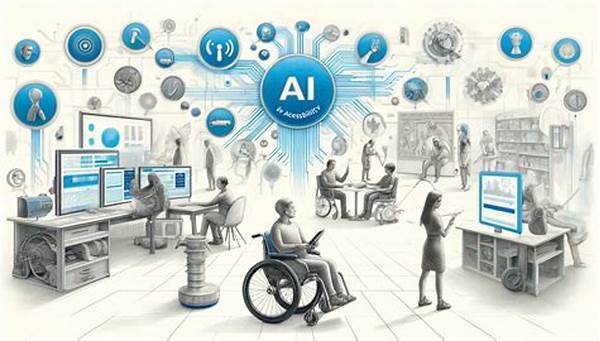AI is shaping the future, or so they say. But what if this future remains out of reach for a significant portion of our society? Accessibility in AI Systems isn’t just a buzzword; it’s a necessity. Imagine a world where AI empowers independence for those with disabilities, offering them equal opportunities and revolutionizing daily life. Yet, the reality is starkly different – many AI systems still remain inaccessible to those who need them the most. The challenge is real, and the stakes are high. But this also presents an unprecedented opportunity for developers, innovators, and businesses to step up, not just to embrace a broader market but to shape a future that’s inclusive and just.
The promise of accessibility in AI systems extends beyond mere altruism. It’s about tapping into a market brimming with potential. Companies that prioritize inclusivity can transform lives, turn consumers into brand champions, and navigate paths of innovation previously unexplored. It’s the winning strategy that builds loyalty and goodwill. Why should this matter? Because when AI fails to accommodate everyone, it inadvertently creates barriers, leaving valuable insights and ingenuity untapped. The call is clear: accessibility in AI systems isn’t just beneficial, it’s crucial.
Designing the Future with Accessibility in AI Systems
Integrating accessibility into AI systems demands dedication, innovation, and, most importantly, perspective. By adopting inclusive design principles from the outset, developers ensure technology works for everyone. Take, for instance, speech recognition software – a vital tool for those with limited physical mobility. When tailored for diverse accents and different speech patterns, it becomes an indispensable asset in bridging communication gaps. However, this is but a slice of the pie.
For stories of transformation, look no further than testimonials from users who’ve experienced the life-changing potential of accessible AI. Their voices echo the power of technology that understands and meets their needs. This shift doesn’t just serve those with disabilities; it innovates for all. Stories abound of businesses harnessing accessibility in AI systems to unlock creativity and strength within their teams. It’s a narrative of progress where no one is left behind, and that’s an endeavor worth pursuing.
—
Understanding Accessibility in AI Systems
Creating accessible AI systems involves weaving inclusivity into the very fabric of AI development. It’s not just a feature; it’s a fundamental aspect that demands our attention. The statistics are staggering – over a billion people worldwide live with some form of disability. The exclusion of such a significant demographic isn’t just a missed opportunity; it’s a failure to honor the rights of all individuals. So, how do we shift the paradigm?
Why Accessibility Matters in AI Systems
One key step lies in awareness and education. By promoting a deeper understanding of accessibility in AI systems, developers can appreciate the vast potential they unlock by catering to diverse needs. Consider an app with alternative text for visually impaired users or a voice-activated assistant equipped to understand all voices, not just the mainstream. These are not mere luxuries; they are essentials guided by empathy and insight.
Moreover, integrating accessibility in AI systems isn’t just a compliance requirement; it’s a business advantage. Inclusive technology can drive innovation and growth. Organizations that commit to accessibility often find themselves at the cutting edge, pioneering solutions that competitors eventually follow. The AI landscape is changing, and those who don’t adapt risk being left behind.
Recognizing the benefits doesn’t mean the journey is without challenges. It’s essential to involve users throughout the development process. By collecting feedback from those with disabilities, AI systems become more inclusive and intuitive. This direct involvement leads to meaningful, authentic solutions that revolutionize technology use for millions.
In conclusion, embracing accessibility in AI systems heralds an era of innovation that champions diversity and inclusion. It’s a narrative that appeals not just to the mind but also to the heart, emphasizing the role technology plays in shaping a fair and equitable future for all.
—
Descriptive Insights into Accessibility in AI Systems
Innovation is at the heart of accessibility in AI systems, yet, it extends far beyond mere technological advancements. Reimagining accessibility involves crafting experiences that resonate with users, blurring the divide between necessity and luxury. It becomes a journey where every input, every feature, elevates the user experience, making it more seamless, intuitive, and rewarding.
The role of AI in fostering inclusion cannot be overstated. It isn’t solely about adaptations; it’s about recognizing potential. Whether through AI-driven language models that transcend barriers or interfaces designed with empathy, the interplay of technology and accessibility manifests a world where everyone belongs. This future is built not by circumventing disabilities but by empowering individuals, showcasing a blend of creativity and pragmatism through the lens of AI.
—
By embedding accessibility in AI systems, we are pioneering a tipping point in which technology transforms from exclusive to universally appealing, rendering inert barriers that have long hindered progress. Engaging in this dialogue offers a fresh perspective on what AI truly represents – a beacon of hope and catalyst for empowerment, bridging divides and carving out spaces of understanding and possibility.
The power of accessible AI systems is felt deeply when interwoven with narratives of real-world impact. These stories vividly spotlight transformative outcomes, rooting innovations in genuine human interaction. Developers, businesses, and advocates alike are united in this mission, exploring new horizons where accessibility pivots from an afterthought to an integral cornerstone.
Key Benefits of Implementing Accessibility in AI Systems
Today’s AI systems must unite technology with empathy, creativity, and insight. Explore this exhilarating journey. Embrace the shift. The future of accessibility in AI systems beckons us to lead a movement towards a society inherently inclusive, equitable, and infinitely brighter for all.

